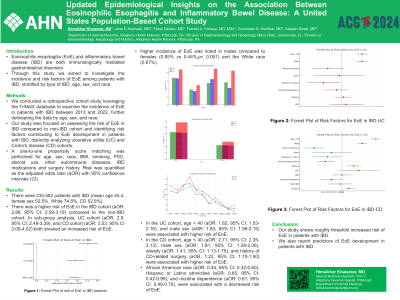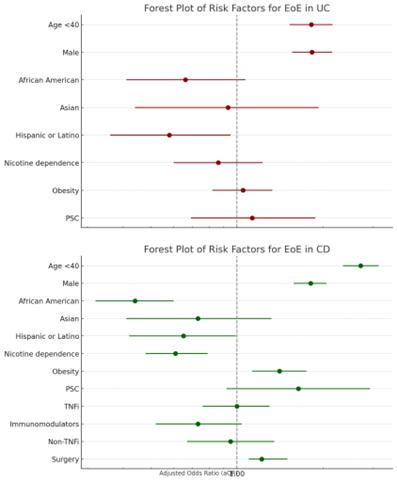Sunday Poster Session
Category: IBD
P0873 - Updated Epidemiological Insights on the Association Between Eosinophilic Esophagitis and Inflammatory Bowel Disease: A United States Population-Based Cohort Study
Sunday, October 27, 2024
3:30 PM - 7:00 PM ET
Location: Exhibit Hall E

Has Audio

Himsikhar Khataniar, MD
Allegheny General Hospital
Pittsburgh, PA
Presenting Author(s)
Himsikhar Khataniar, MD1, Jana G. Hashash, MD, MSc2, Fjona Tabaku, MD1, Francis A. Farraye, MD, MSc2, Gursimran S. Kochhar, MD1, Aakash Desai, MD3
1Allegheny General Hospital, Pittsburgh, PA; 2Mayo Clinic, Jacksonville, FL; 3Mayo Clinic, Pittsburgh, PA
Introduction: Eosinophilic esophagitis (EoE) and inflammatory bowel disease (IBD) are both immunologically mediated gastrointestinal disorders. Through this study we aimed to investigate the incidence, and risk factors of EoE among patients with IBD, stratified by type of IBD, age, sex, and race.
Methods: We conducted a retrospective cohort study leveraging the TriNetX database to examine the incidence of EoE in patients with IBD between 2013 and 2022, further delineating the data by age, sex, and race. Our study also focused on assessing the risk of EoE in IBD compared to non-IBD cohort and identifying risk factors contributing to EoE development in patients with IBD, distinctly analyzing ulcerative colitis (UC) and Crohn's disease (CD) cohorts. A one-to-one propensity score matching was performed for age, sex, race, BMI, smoking, PSC, steroid use, other autoimmune diseases, IBD medications and surgery history. Risk was quantified as the adjusted odds ratio (aOR) with 95% confidence intervals (CI).
Results: There were 234,582 patients with IBD (mean age 45.4, female sex 52.5%, White 74.8%, CD 52.8%). There was a higher risk of EoE in the IBD cohort (aOR: 2.88, 95% CI: 2.59-3.19) compared to the non-IBD cohort. In sub-group analysis, UC cohort (aOR: 2.9, 95% CI: 2.49-3.39), and CD cohort (aOR: 3.53, 95% CI 3.09-4.02) both showed an increased risk of EoE. Higher incidence of EoE was noted in males compared to females (0.85% vs 0.44%,p< 0.001) and the White race (0.67%). In the UC cohort, age < 40 (aOR: 1.82, 95% CI: 1.53-2.16), and male sex (aOR: 1.83, 95% CI: 1.56-2.15) were associated with higher risk of EoE. In the CD cohort, age < 40 (aOR: 2.71, 95% CI: 2.35-3.13), male sex (aOR: 1.81, 95% CI: 1.58-2.06), obesity (aOR: 1.41, 95% CI: 1.13-1.75), and history of CD-related surgery (aOR: 1.22, 95% CI: 1.10-1.50) were associated with higher risk of EoE. African American race (aOR: 0.44, 95% CI: 0.32-0.60), Hispanic or Latino ethnicities (aOR: 0.65, 95% CI: 0.42-0.99), and nicotine dependence (aOR: 0.61, 95% CI: 0.48-0.79), were associated with a decreased risk of EoE.
Discussion: Our study shows roughly threefold increased risk of EoE in patients with IBD. We also report predictors of EoE development in patients with IBD.

Note: The table for this abstract can be viewed in the ePoster Gallery section of the ACG 2024 ePoster Site or in The American Journal of Gastroenterology's abstract supplement issue, both of which will be available starting October 27, 2024.
Disclosures:
Himsikhar Khataniar, MD1, Jana G. Hashash, MD, MSc2, Fjona Tabaku, MD1, Francis A. Farraye, MD, MSc2, Gursimran S. Kochhar, MD1, Aakash Desai, MD3. P0873 - Updated Epidemiological Insights on the Association Between Eosinophilic Esophagitis and Inflammatory Bowel Disease: A United States Population-Based Cohort Study, ACG 2024 Annual Scientific Meeting Abstracts. Philadelphia, PA: American College of Gastroenterology.
1Allegheny General Hospital, Pittsburgh, PA; 2Mayo Clinic, Jacksonville, FL; 3Mayo Clinic, Pittsburgh, PA
Introduction: Eosinophilic esophagitis (EoE) and inflammatory bowel disease (IBD) are both immunologically mediated gastrointestinal disorders. Through this study we aimed to investigate the incidence, and risk factors of EoE among patients with IBD, stratified by type of IBD, age, sex, and race.
Methods: We conducted a retrospective cohort study leveraging the TriNetX database to examine the incidence of EoE in patients with IBD between 2013 and 2022, further delineating the data by age, sex, and race. Our study also focused on assessing the risk of EoE in IBD compared to non-IBD cohort and identifying risk factors contributing to EoE development in patients with IBD, distinctly analyzing ulcerative colitis (UC) and Crohn's disease (CD) cohorts. A one-to-one propensity score matching was performed for age, sex, race, BMI, smoking, PSC, steroid use, other autoimmune diseases, IBD medications and surgery history. Risk was quantified as the adjusted odds ratio (aOR) with 95% confidence intervals (CI).
Results: There were 234,582 patients with IBD (mean age 45.4, female sex 52.5%, White 74.8%, CD 52.8%). There was a higher risk of EoE in the IBD cohort (aOR: 2.88, 95% CI: 2.59-3.19) compared to the non-IBD cohort. In sub-group analysis, UC cohort (aOR: 2.9, 95% CI: 2.49-3.39), and CD cohort (aOR: 3.53, 95% CI 3.09-4.02) both showed an increased risk of EoE. Higher incidence of EoE was noted in males compared to females (0.85% vs 0.44%,p< 0.001) and the White race (0.67%). In the UC cohort, age < 40 (aOR: 1.82, 95% CI: 1.53-2.16), and male sex (aOR: 1.83, 95% CI: 1.56-2.15) were associated with higher risk of EoE. In the CD cohort, age < 40 (aOR: 2.71, 95% CI: 2.35-3.13), male sex (aOR: 1.81, 95% CI: 1.58-2.06), obesity (aOR: 1.41, 95% CI: 1.13-1.75), and history of CD-related surgery (aOR: 1.22, 95% CI: 1.10-1.50) were associated with higher risk of EoE. African American race (aOR: 0.44, 95% CI: 0.32-0.60), Hispanic or Latino ethnicities (aOR: 0.65, 95% CI: 0.42-0.99), and nicotine dependence (aOR: 0.61, 95% CI: 0.48-0.79), were associated with a decreased risk of EoE.
Discussion: Our study shows roughly threefold increased risk of EoE in patients with IBD. We also report predictors of EoE development in patients with IBD.

Figure: Forest plots of risk factors for EoE in patients with IBD expressed as adjusted odds ratio with 95% confidence intervals.
Note: The table for this abstract can be viewed in the ePoster Gallery section of the ACG 2024 ePoster Site or in The American Journal of Gastroenterology's abstract supplement issue, both of which will be available starting October 27, 2024.
Disclosures:
Himsikhar Khataniar indicated no relevant financial relationships.
Jana Hashash: Bristol Myers Squibb – Consultant.
Fjona Tabaku indicated no relevant financial relationships.
Francis Farraye: AbbVie – Consultant. Avalo Therapeutics – Consultant. Bausch – Advisor or Review Panel Member. BMS – Consultant. Braintree Labs – Consultant. DSMB for Lilly. – Sits on. Fresenius Kabi – Consultant. GI Reviewers and IBD Educational Group – independent contractor. GSK, Iterative Health, Janssen, Pfizer, Pharmacosmos, Sandoz Immunology, Sebela and Viatris – Consultant.
Gursimran Kochhar: Boston Scientific Endoscopy – Consultant. DigbI – Stock Options. Eli Lilli – Advisory Committee/Board Member, Speakers Bureau. Olympus Endoscopy – Consultant. Pentax Endoscopy – Consultant. Takeda – Consultant.
Aakash Desai indicated no relevant financial relationships.
Himsikhar Khataniar, MD1, Jana G. Hashash, MD, MSc2, Fjona Tabaku, MD1, Francis A. Farraye, MD, MSc2, Gursimran S. Kochhar, MD1, Aakash Desai, MD3. P0873 - Updated Epidemiological Insights on the Association Between Eosinophilic Esophagitis and Inflammatory Bowel Disease: A United States Population-Based Cohort Study, ACG 2024 Annual Scientific Meeting Abstracts. Philadelphia, PA: American College of Gastroenterology.

